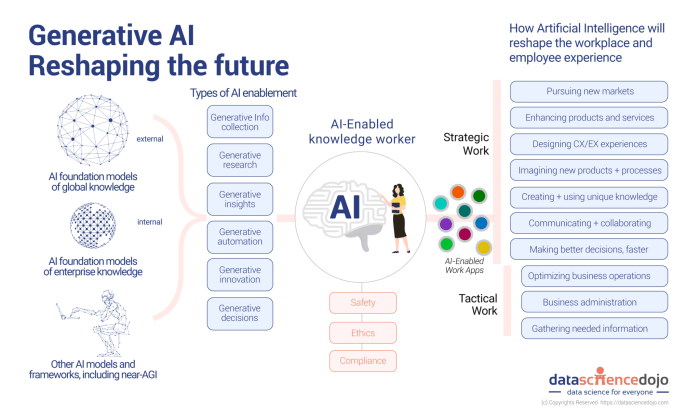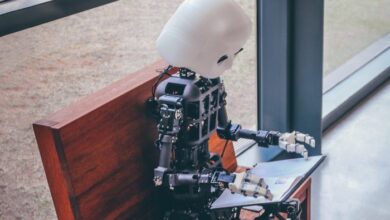
Prepare Generative AI Intelligence: A Guide
Prepare Generative AI Intelligence: A Guide is a deep dive into the world of AI that creates, not just analyzes. This isn’t just about understanding the technology, it’s about preparing for its impact on industries, jobs, and even our ethical considerations.
We’ll explore the fundamentals, the potential, and the practical steps to harness the power of generative AI.
Generative AI is transforming the way we interact with technology, and understanding its capabilities is crucial for navigating the future. From crafting realistic images to composing music, generative AI is blurring the lines between human and machine creativity. But with this power comes responsibility, and we’ll examine the ethical dilemmas and potential pitfalls that come with this technology.
Understanding Generative AI
Generative AI is a rapidly evolving field within artificial intelligence (AI) that focuses on creating new content, such as text, images, audio, and video. Unlike traditional AI models that analyze existing data, generative AI models learn patterns from existing data and use that knowledge to generate new, original content.
Key Principles of Generative AI
Generative AI models are based on the principle of learning from data and using that knowledge to create new content. This process involves two main phases: training and generation.During the training phase, the model is fed a massive dataset of existing content.
The model learns to identify patterns, relationships, and characteristics within the data. This process can be likened to a student studying a textbook to learn the rules of grammar and vocabulary.In the generation phase, the model uses its learned knowledge to create new content.
It draws upon the patterns and relationships it identified during training to generate outputs that are similar in style and structure to the training data. This is analogous to the student using their knowledge to write a new essay or story.
Examples of Generative AI Models and Applications
Generative AI has a wide range of applications across various industries. Here are some examples:
Text Generation
Language Models
Models like GPT-3 (Generative Pre-trained Transformer 3) can generate human-quality text, translate languages, write different kinds of creative content, and answer your questions in an informative way.
Chatbots
Generative AI powers chatbots that can engage in natural conversations with users, providing customer support, answering questions, and even creating personalized experiences.
Image Generation
DALL-E 2
This model can generate realistic images from text descriptions. For example, you can ask it to create an image of a “cat wearing a hat” and it will produce a visually appealing image that matches your request.
Stable Diffusion
Another popular model that can generate images from text prompts. It offers more control over the image generation process, allowing users to fine-tune aspects like style, composition, and detail.
Preparing for the generative AI revolution means understanding the landscape and its key players. Samsung, with its recent focus on next-generation gaming technology, is a prime example. Check out the GamesBeat profile on Samsung Next to see how they’re pushing the boundaries of interactive experiences.
This kind of innovation is crucial to developing the infrastructure needed for AI to thrive in the gaming space and beyond.
Audio Generation
Jukebox
This model can generate different musical genres and styles, including hip-hop, country, and classical music. It can even create songs with specific lyrics or melodies.
Getting a handle on generative AI is crucial for staying ahead of the curve, but sometimes you just need a break from the tech talk. That’s where a delicious brunch comes in! I’m dreaming of a Vietnamese breakfast pizza from the Pachamama Group, like the one featured in this article.
After a good meal, I’ll be ready to dive back into exploring the potential of generative AI.
WaveNet
This model can synthesize realistic-sounding speech, allowing for the creation of synthetic voices for applications like text-to-speech software and virtual assistants.
Preparing for the generative AI revolution is like prepping for a big adventure. You need the right gear, and right now, you can score some awesome deals on Regatta Ireland gear with a limited offer – hurry limited offer save e10 on e55 orders at regatta ireland.
Just like a sturdy jacket can keep you warm, having the right generative AI knowledge can help you navigate this exciting new landscape.
Differences Between Generative AI and Traditional AI
Generative AI and traditional AI are distinct approaches to artificial intelligence. Here are some key differences:
| Characteristic | Generative AI | Traditional AI |
|---|---|---|
| Purpose | Create new content | Analyze existing data |
| Data Usage | Learns from existing data to generate new content | Analyzes existing data to identify patterns and make predictions |
| Examples | Text generation, image generation, music composition | Image classification, object detection, fraud detection |
Preparing for Generative AI Intelligence
Generative AI is poised to revolutionize numerous industries, impacting how we work, create, and interact with technology. Understanding its potential and preparing for its implications is crucial for individuals and organizations alike.
Impact on Industries
Generative AI’s transformative power extends across various sectors, offering both opportunities and challenges.
- Content Creation:Generative AI models can create high-quality content, such as articles, marketing materials, and even scripts, automating tasks and reducing time and effort. This could significantly impact industries like publishing, advertising, and entertainment.
- Design and Engineering:Generative AI can assist in designing products, buildings, and even complex systems. It can analyze data, generate multiple design options, and optimize for specific criteria, accelerating the design process and fostering innovation.
- Healthcare:Generative AI can be used to analyze medical images, assist in drug discovery, and personalize treatment plans. It can also generate realistic synthetic data for training medical AI models, enhancing the accuracy and effectiveness of healthcare applications.
- Education:Generative AI can personalize learning experiences, create interactive educational content, and provide students with tailored feedback. It can also assist teachers in grading assignments and providing personalized support.
- Customer Service:Generative AI can power chatbots and virtual assistants, providing 24/7 customer support and answering inquiries in a personalized and efficient manner.
Key Skills and Knowledge
To effectively work with generative AI, individuals need to develop a specific set of skills and knowledge.
- Understanding AI Concepts:A solid understanding of core AI concepts, including machine learning, deep learning, and natural language processing, is essential for working with generative AI models.
- Data Handling and Analysis:Generative AI models are trained on large datasets. Proficiency in data handling, cleaning, and analysis is crucial for preparing data for training and evaluating model performance.
- Programming Skills:Knowledge of programming languages like Python, R, or Java is essential for interacting with generative AI models, building applications, and customizing their behavior.
- Model Evaluation and Tuning:Evaluating model performance and fine-tuning its parameters to achieve optimal results is a critical skill. This involves understanding metrics like accuracy, precision, and recall.
- Ethical Considerations:As generative AI becomes more powerful, understanding the ethical implications of its use is crucial. This includes considering issues like bias, fairness, and responsible deployment.
Ethical Considerations
The development and deployment of generative AI raise important ethical concerns that need to be addressed.
- Bias and Discrimination:Generative AI models can perpetuate biases present in the training data, potentially leading to discriminatory outcomes. It’s crucial to ensure data diversity and implement fairness measures to mitigate bias.
- Misinformation and Deepfakes:Generative AI can be used to create realistic synthetic content, including images, videos, and audio, which can be misused to spread misinformation or create deepfakes. Developing detection and verification tools is essential to combat these threats.
- Job Displacement:The automation capabilities of generative AI could lead to job displacement in certain sectors. It’s important to consider strategies for reskilling and upskilling workers to adapt to the changing job market.
- Privacy and Data Security:Generative AI models often require access to large amounts of data, raising concerns about privacy and data security. Implementing strong data protection measures and ensuring responsible data usage is crucial.
- Transparency and Accountability:Understanding how generative AI models make decisions and ensuring transparency in their development and deployment is essential for building trust and accountability.
Building a Generative AI System: Prepare Generative Ai Intel
Building a generative AI system involves a multi-step process that requires a deep understanding of the underlying principles and technologies. From defining the problem to deploying the final model, each step plays a crucial role in the success of the system.
Defining the Problem and Objectives
The initial step in building a generative AI system is to clearly define the problem you want to solve and set specific objectives for the system. This includes understanding the desired output, the type of data required, and the potential applications of the generated content.
Data Acquisition and Preprocessing
Generative AI models rely on large amounts of data for training. The quality and quantity of data are critical to the performance of the model. This step involves gathering relevant data, cleaning it, and transforming it into a format suitable for training.
Model Selection and Architecture
Choosing the right generative AI model architecture is crucial. Different architectures are suitable for different tasks and data types. Common architectures include:
- Generative Adversarial Networks (GANs): These models consist of two networks, a generator and a discriminator, that compete with each other to generate realistic data.
- Variational Autoencoders (VAEs): These models learn a compressed representation of the data and use it to generate new samples.
- Transformer-based models: These models are particularly effective for tasks like text generation and image captioning.
Training and Evaluation, Prepare generative ai intel
Once the model architecture is selected, the next step is to train the model on the prepared data. Training involves adjusting the model’s parameters to minimize the difference between the generated output and the real data. The training process typically involves several epochs, where the model is iteratively trained on the data.
Deployment and Monitoring
After training, the generative AI model is deployed to generate new content. This involves integrating the model into a system or application. It’s important to continuously monitor the model’s performance and make adjustments as needed.
Components of a Generative AI System
A generative AI system typically consists of several components:
- Data Pipeline: This component handles data acquisition, preprocessing, and storage.
- Model Architecture: This defines the structure and parameters of the generative model.
- Training Engine: This component trains the model using the provided data.
- Inference Engine: This component uses the trained model to generate new content.
- Evaluation Metrics: These metrics are used to assess the performance of the model.
Training a Generative AI Model
Training a generative AI model involves feeding the model with a large dataset of examples and allowing it to learn the underlying patterns and relationships within the data. The model then uses this knowledge to generate new outputs that resemble the training data.
Evaluating a Generative AI Model
Evaluating a generative AI model is crucial to assess its performance and ensure it meets the desired objectives. Common evaluation metrics include:
- Inception Score (IS): This metric measures the quality and diversity of generated images.
- Fréchet Inception Distance (FID): This metric compares the distribution of generated images to the distribution of real images.
- BLEU score: This metric measures the quality of generated text by comparing it to human-written text.
Integrating Generative AI into Business Operations

Integrating generative AI into business operations can revolutionize workflows, automate tasks, and unlock new possibilities. It involves strategically adopting generative AI tools and processes to enhance efficiency, creativity, and decision-making across various departments.
Designing a Plan for Integration
To effectively integrate generative AI into a business function, a well-defined plan is crucial. This plan should Artikel the specific goals, target areas, and implementation steps.
Identifying Target Areas
The first step is to identify the specific business functions where generative AI can create the most significant impact. For instance, in marketing, generative AI can be used to create personalized content, generate social media posts, and optimize advertising campaigns.
In customer service, it can be used to automate responses to frequently asked questions and provide personalized recommendations.
Defining Goals and Metrics
Once target areas are identified, the next step is to define clear goals and metrics to measure the success of the integration. These goals could include increased efficiency, improved customer satisfaction, or enhanced revenue generation.
Developing a Roadmap
The roadmap should Artikel the steps involved in implementing generative AI, including the selection of tools, training of employees, and integration with existing systems.
Organizing a Workflow for Generative AI
A well-organized workflow is essential for maximizing the benefits of generative AI. This workflow should define the tasks, roles, and processes involved in using generative AI to automate tasks and improve efficiency.
Task Automation
Generative AI can automate a wide range of tasks, from generating reports to creating presentations. By automating these tasks, businesses can free up employees to focus on more strategic activities.
Workflow Optimization
Generative AI can also be used to optimize workflows by identifying bottlenecks and streamlining processes. For example, generative AI can analyze data from customer interactions to identify areas where customer service can be improved.
Human-AI Collaboration
It is important to remember that generative AI is a tool, not a replacement for human expertise. The most effective approach is to integrate generative AI into workflows in a way that enhances human capabilities, rather than replacing them entirely.
Managing Risks and Opportunities
The implementation of generative AI also presents both risks and opportunities. It is essential to develop a strategy for managing these risks and maximizing the opportunities.
Addressing Ethical Concerns
Generative AI raises ethical concerns related to data privacy, bias, and the potential for misuse. It is crucial to implement safeguards to address these concerns.
Ensuring Data Security
Generative AI relies heavily on data, so ensuring the security of this data is paramount. Businesses must implement robust security measures to protect data from unauthorized access or breaches.
Promoting Transparency and Accountability
Transparency and accountability are essential for building trust in generative AI. Businesses should be transparent about how they are using generative AI and be accountable for its impact.
Leveraging Generative AI for Innovation
Generative AI can be a powerful tool for driving innovation. By using generative AI to explore new ideas and concepts, businesses can unlock new possibilities and create innovative products and services.
Future of Generative AI
The field of generative AI is rapidly evolving, promising transformative advancements across various domains. As research and development continue, we can expect to witness groundbreaking innovations that will reshape our world in profound ways.
Potential Breakthroughs
Generative AI has the potential to revolutionize various industries, leading to unprecedented breakthroughs. Here are some key areas where significant progress is anticipated:
- Enhanced Creativity and Innovation:Generative AI will empower individuals and organizations to unleash their creativity and generate novel ideas, designs, and solutions. This will accelerate innovation across fields such as art, design, music, and scientific research.
- Personalized Experiences:Generative AI will enable the creation of highly personalized experiences tailored to individual preferences and needs. This will revolutionize industries like e-commerce, entertainment, and education, offering customized products, services, and learning experiences.
- Accelerated Scientific Discovery:Generative AI will play a crucial role in accelerating scientific discovery by automating complex tasks, analyzing vast datasets, and generating hypotheses. This will lead to breakthroughs in fields like medicine, materials science, and climate research.
- Improved Efficiency and Automation:Generative AI will automate repetitive and time-consuming tasks, freeing up human resources for more creative and strategic endeavors. This will enhance efficiency across various industries, including manufacturing, logistics, and customer service.
Challenges and Ethical Considerations
While the potential of generative AI is vast, it also presents significant challenges and ethical considerations that need to be addressed:
- Bias and Fairness:Generative AI models are trained on massive datasets, which may contain biases. This can lead to biased outputs, perpetuating existing inequalities and discrimination. It is crucial to develop techniques for mitigating bias and ensuring fairness in generative AI systems.
- Misinformation and Deepfakes:Generative AI can be used to create highly realistic fake content, including images, videos, and audio. This raises concerns about the spread of misinformation and the potential for malicious use, such as creating deepfakes for propaganda or fraud.
- Job Displacement:As generative AI automates tasks previously performed by humans, there is a risk of job displacement. It is essential to address this challenge by investing in workforce training and reskilling programs to prepare individuals for the evolving job market.
- Privacy and Security:Generative AI models often require access to large amounts of personal data. This raises concerns about privacy and security, as unauthorized access or misuse of this data could have serious consequences. It is crucial to develop robust data protection measures and ensure responsible data handling practices.
Emerging Trends and Research Areas
Generative AI research is constantly evolving, with new trends and research areas emerging:
- Multimodal Generative AI:This involves developing models that can generate different types of content, such as text, images, and audio, simultaneously. This opens up exciting possibilities for creating more immersive and interactive experiences.
- Generative AI for Code:This involves using generative AI to generate code, automating software development tasks, and improving code quality. This has the potential to revolutionize the software development industry.
- Explainable Generative AI:This aims to make generative AI models more transparent and understandable, allowing users to understand how they work and why they generate specific outputs. This is crucial for building trust and ensuring responsible use of generative AI.
- Generative AI for Social Good:This involves using generative AI to address social challenges, such as creating personalized educational content, generating innovative solutions for climate change, or developing assistive technologies for people with disabilities.







